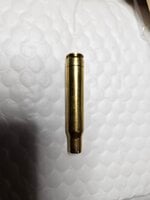nosler06
Handloader
- Nov 13, 2012
- 250
- 23
I have some older Norma 30-06 brass that has been reloaded well over 15 times now and has been annealed. I just found 2 cases with what I call a crack ring on them. I attached a picture of one of the cases. My question is with showing 2 cases of this type of separation would it be best to scrap all of the remaining cases to avoid any chance of another case possibly separating either in the reloading die or worse in the chamber. What do you all feel about it? Thank you for any suggestions. 






